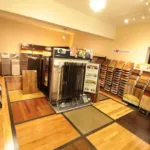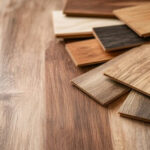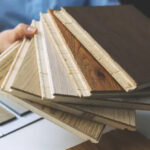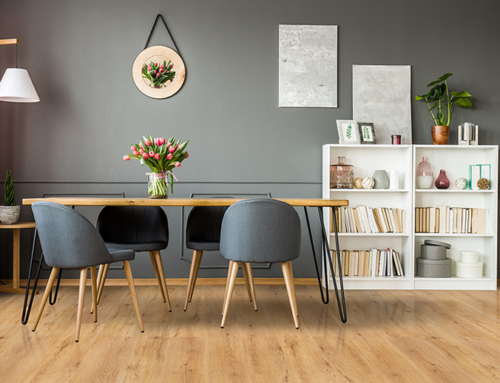This comprehensive guide to refinishing hardwood floors is designed to provide a thorough overview of the process, from initial preparation to final maintenance. While this article doesn’t replace the expertise of a professional hardwood flooring specialist, it offers insights into the refinishing process, standard procedures, and post-refinishing care.
Hardwood floor refinishing is a transformative process involving the removal of the old finish and the reveal of the fresh, raw wood beneath. This raw wood is then coated with a new finish, typically adhering to NWFA (National Wood Flooring Association) standards. Refinishing can breathe new life into old or worn floors and even change the floor’s color or finish to better match your interior decor. In this guide, we’ll delve into the refinishing process, tools, materials, and essential tips.
Preparing the Floor For Your Atlanta Home
Before the refinishing process begins, it’s vital to clear the floor of any debris, furniture, and decorations. This meticulous cleaning ensures a pristine outcome, as even tiny particles of dust or debris can mar the finished product. Although professional installers will perform a thorough cleaning, prepping the floor in advance is recommended for the best results.
Belt Sanding / Drum Sanding
The first major step in hardwood floor refinishing involves using a drum sander, a robust machine with a rotating sanding drum powered by an electric motor. Here are the key steps for belt sanding:
- Choose the right sandpaper: Select the appropriate grit sandpaper based on the floor’s condition and the desired finish level.
- Start the sander: Turn on the sander and commence sanding in straight lines, working systematically across the room.
- Keep the sander moving: Maintain consistent pressure and motion to prevent unevenness. Multiple passes with progressively finer sandpaper may be necessary for a smooth finish.
Edging
Edging is the process of sanding areas around the floor’s edges and in corners inaccessible to the drum sander. After the main floor sanding, use a smaller, hand-held edger sander for these areas. Follow these steps for edging:
- Turn on the edger sander: Start the edger sander and sand in straight lines along the room’s perimeter.
- Maintain consistent pressure: Avoid creating dips or unevenness by keeping steady pressure and motion.
- Sand the corners: Pay special attention to corners, ensuring they are uniformly sanded.
- Vacuum and dust the floor: After sanding, thoroughly clean the floor to remove any remaining debris, fill holes or cracks with wood filler, and sand them smooth.
Buffing / Planetary Sanding
Buffing, done after sanding and refinishing, utilizes a floor buffer to polish and enhance the floor. It helps to remove any missed scratches or imperfections during the sanding process. Typically done with 80 to 120 grit sandpaper or screens, buffing is the final step in hardwood floor refinishing.
Vacuuming
Vacuuming between each step is advisable to keep the floor debris-free and prepared for the next phase.
Different Refinishing Options in Atlanta
Staining
Staining hardwood floors involves applying colored pigments to alter the wood’s appearance. This can give old floors a fresh look or match the floor’s color with your room decor. After staining, apply a clear finish like polyurethane for protection and shine. Staining can be time-consuming and requires specialized tools, but it results in a durable and aesthetically pleasing floor.
Finish Options
- Water-Based Floor Finish: Environmentally friendly, clear, and non-yellowing.
- Oil-Based Finish: Durable, long-lasting, but may yellow over time.
- Penetrating Finish: Absorbs into the wood for natural, matte finish, ideal for maintaining wood’s appearance.
The Imperfections in Hardwood Floors
Natural wood inherently contains variations in color, grain, and other features. Imperfections such as knots, cracks, and blemishes are part of wood’s charm. Over time, wear and tear can result in scratches and dents. These are normal aspects of wood floors and contribute to their unique character and beauty.
Maintaining Refinished Hardwood Floors
To keep your refinished hardwood floor in great condition:
- Regularly clean it with a broom or vacuum.
- Use protective mats and rugs in high-traffic areas.
- Avoid water damage by promptly drying spills.
- Protect the floor from furniture with pads.
While refinishing won’t make hardwood floors perfect, it significantly improves their appearance, making them look refreshed and polished. Natural wood variations and imperfections are what make hardwood floors truly special and appealing.
FAQ’s & Video Information on Refinishing Hardwood Flooring in Atlanta
Dust can be an issue if the professional lacks the appropriate equipment. However, when equipped with the right tools, the dust generated during the refinishing process is comparable to what you might encounter on a typical day in a household. Modern vacuum systems are highly efficient and effectively capture dust. It’s worth noting that most professional hardwood floor sanders utilize specialized vacuums designed for this purpose, which are far more effective than standard household vacuums.
Yes, you can change the color of your hardwood floors by using a different stain during the refinishing process. This allows you to update the look of your floors to match your decor.
Yes, it’s essential to clear the area of furniture and vacate the premises during the refinishing process for safety and to allow the professionals to work efficiently.
The time it takes to refinish hardwood floors depends on factors like the size of the area, the condition of the floors, and the number of coats needed. On average, it can take 2-5 days, including drying times.
The typical steps in hardwood floor refinishing include sanding, staining (if desired), and applying a finish coat. Sanding removes the old finish and imperfections, staining adds color, and the finish coat provides protection and sheen.
While some homeowners with DIY skills may attempt hardwood floor refinishing, it is often best left to professionals. DIY refinishing can lead to uneven results, damage, or even costly mistakes.
You should consider refinishing your hardwood floors when they show signs of wear, such as deep scratches, dullness, or when the existing finish starts to wear off. Typically, this occurs every 7-10 years, but it depends on foot traffic and maintenance.
Hardwood floor refinishing is the process of sanding down the top layer of your hardwood floors to remove scratches, stains, and imperfections, followed by applying a new finish to restore their beauty and protect them.
Author Profile
- I have worked in hardwood flooring for the last 8 years. Use to run a company of residential crews as well as a company with gym flooring. If you need floor installation or refinishing help, I should have an answer or at least get you in the right direction.
Latest entries
 FlooringDecember 24, 2025Right Advice For Picking The Ideal Hardwood Flooring Options
FlooringDecember 24, 2025Right Advice For Picking The Ideal Hardwood Flooring Options FlooringDecember 22, 2025What is Your Favorite Type of Hardwood Flooring and Why?
FlooringDecember 22, 2025What is Your Favorite Type of Hardwood Flooring and Why? FlooringDecember 15, 2025What is the Most Durable Engineered Hardwood Flooring?
FlooringDecember 15, 2025What is the Most Durable Engineered Hardwood Flooring? FlooringDecember 12, 2025How Do You Maintain Vinyl Flooring in Spokane Homes?
FlooringDecember 12, 2025How Do You Maintain Vinyl Flooring in Spokane Homes?


